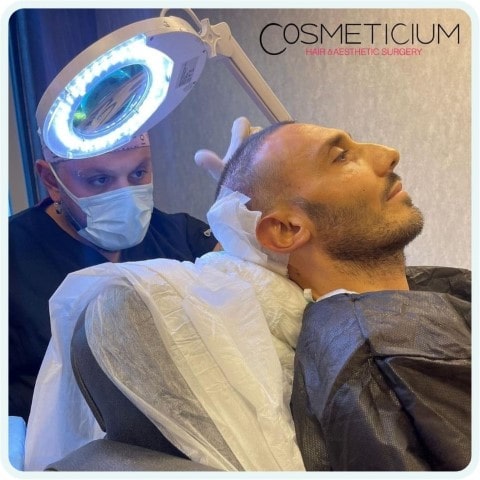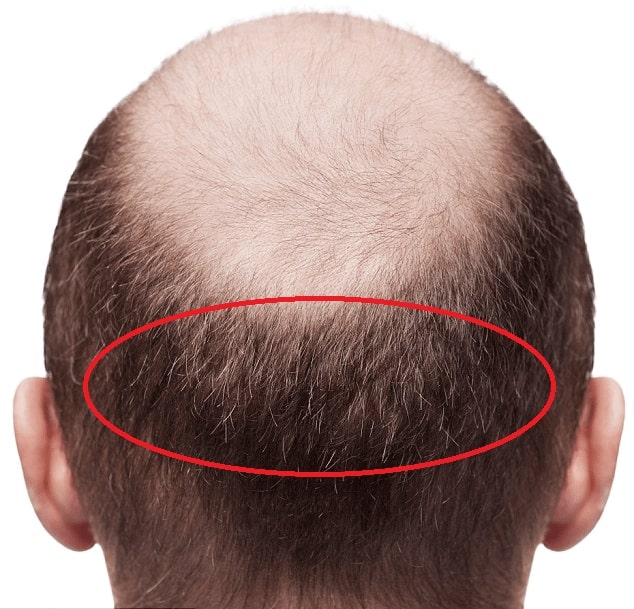Your Hair Transplant surgeon will need to examine your donor area to determine how many hairs can be transplanted. The size of the bald surface and the density you want to achieve will also determine if your donor hair is sufficient. Our expert hair transplant surgeons work hard to preserve your donor area as much as possible to ensure that the area can be used again should you require a hair transplant again in the future whilst also ensuring that any scarring is minimal allowing the patient to wear their hair short post-hair transplant procedure should they wish.
Table of Contents
What is Hair Transplantation?
Hair transplantation is a surgical procedure in which hair is removed from one area of the scalp and transplanted to another. The hair may be removed from the back or sides of the head, or from another area of the body such as the chest or beard.
The most common type of hair transplantation is called follicular unit transplantation (FUT). In this procedure, a strip of skin containing hair follicles is removed from the donor area and divided into individual grafts. The grafts are then transplanted to the balding or thinning areas of the scalp.
Another type of hair transplantation, called follicular unit extraction (FUE), involves individually extracting hair follicles from the donor area and transplanting them to the recipient site. FUE is often used for patients who have a small balding or thinning area and do not want a visible scar.
Hair transplants can be an effective treatment for male pattern baldness and other forms ofhair loss. However, it is important to consult with a hair loss specialist to determine if you are a good candidate for this procedure.
What is a Donor Area?
A donor area is the part of the head from which hair follicles are taken for a hair transplant. The ideal donor area is one that is dense with healthy hair follicles and has good blood supply. The most common donor area is the back of the head, where the scalp is usually thicker and less likely to be affected by balding. Other potential donor areas include the sides of the head and the nape of the neck.
How Many Hairs Can Be Transplanted?
There are a number of factors that contribute to how many hairs can be transplanted, including the size and density of the donor area, the type of hair loss, and the desired results. In general, however, most patients can expect to have between 2,000 and 4,000 hairs transplanted. This is enough to create a significant difference in appearance for most patients.
Factors that Determine the Amount of Hair Available for Hair Transplantation
There are a few factors that determine the amount of hair available for hair transplantation. The first is the density of the hair on the donor area. The second is the caliber of the hair, which is determined by the thickness of the individual hairs. And lastly, the size of the donor area.
The density of the hair on the donor area is one of the most important factors in determining how much hair is available for transplantation. The denser the hair, the more grafts can be harvested from that area. However, it is also important to keep in mind that not all patients will have dense hair on their donor areas. In fact, some patients may have very sparse Hair transplantation surgery requires a certain number of grafts to be transplanted in order to achieve desired results, so it’s important to make sure that there are enough hairs in each follicular unit (or “graft”) to meet this demand.

Caliber, or thickness, of individual hairs is another factor that comes into play when determining how many grafts can be harvested from a given area. Generally speaking, thicker hairs yield more grafts than thinner hairs. This is because thicker hairs tend to be stronger and less likely to break during extraction and/or transplantation procedures. As such, they can be trimmed down into smaller sizes without sacrificing their overall strength or integrity. This means that more thinner hairs are needed to achieve similar results as fewer thicker ones.
What Are The Options If I Don’t Have Enough Donor Hair?
If you are not sure whether you have enough donor hair for a hair transplant, there are a few options you can explore.
One option is to consult with a hair loss specialist or dermatologist to assess the amount of donor hair available. They may be able to give you an estimate of how many grafts you could expect to harvest from the donor area.
Another option is to consult with a hair transplant surgeon. They will be able to examine your scalp and assess the amount of donor hair available. If they feel that you do not have enough donor hair, they may suggest other options such as medication or scalp reduction surgery.
If you are still unsure whether you have enough donor hair, you can always seek out a second opinion from anotherhair transplant surgeon.
Conclusion
In conclusion, it’s important to consider a few factors before deciding whether hair transplantation is the best solution for you. It is recommended that you consult with a qualified doctor who can assess your individual situation and determine if there are enough donor hairs available. Additionally, they can help guide you through the entire process of researching and understanding all of the details associated with this treatment option so that you feel confident in making an informed decision. With the right information and support, anyone looking to improve their appearance can benefit from hair transplantation.



